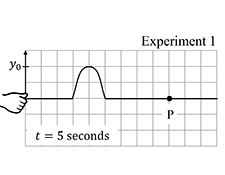
Reflection and transmission of pulses
Variant i Dynamics first Other Variants Interactive tutorial lecture
Students investigate reflection and transmission at a boundary in one dimension. The tutorial provides background for refraction of waves.
Topics Waves and optics / Waves: models, representations, fixed end reflection, free end reflection, frequency & wavelength, reflection/transmission at a boundary, and wave (or pulse) speed
Materials
Materials by the UW team
- Group Handout


- Instructor Guide


- Pretest


- Exam Questions



- Equipment List

Tutorial details
The tutorial begins by showing students a time sequence of photographs that illustrates the behavior of two springs joined end-to-end when a pulse reaches the boundary between them. Students compare the speed of a pulse in one spring to the speed of a pulse in the other, and are asked to compare the tensions and the linear mass densities. At this point, students are asked to check their answers with a tutorial instructor. Many students make the same errors in their comparisons of the tensions and the linear mass densities as on the pretest.
Next students consider what would happen if two identical pulses were sent toward the boundary between the two springs discussed above. They are led to make several comparisons between the transmitted and incident pulses. For example, students are asked to compare the time taken for successive crests to pass a given point in each of the springs. They also compare the distance between the transmitted crests to that between the incident crests. The reasoning involved is challenging for most students. Pulses were used rather than a periodic wave so that students could not reason solely on the basis of equations (e.g., v = λf). Students are led to recognize that the change in width of a pulse as it passes from one spring to the next is a direct consequence of the difference in wave speed in the two springs.
Students then predict what would happen if a pulse were incident on the boundary from the right, rather than the left. Some students incorrectly predict that there will be no reflected pulse since the second spring in this case is “lighter” than the first. Others do not recognize that the reflected pulse is not inverted in this case. Students then check their predictions using a time sequence of photographs.
In the final part of the tutorial, students summarize what they have observed. They come to recognize that the relative linear mass densities of the springs (or alternatively, the relative wave speeds) can be used to determine whether the reflection at the boundary is more like reflection from a fixed end or from a free end.
For instruction tips, login or register as a verified educator to see the Instructor Guide.
Prerequisites
Prerequisite tutorials
The Superposition of pulses tutorial is a prerequisite to Reflection and transmission of pulses.
Other prerequisites
This tutorial builds on Superposition and reflection of pulses. An understanding of kinematics and dynamics is expected, as is the relationship between the wave speed, v, the tension in the spring, T, and the linear mass density of the spring, μ.
Equipment
Special Instructions
Make one copy of the handout for each group, on paper, of the handout “Pulse passing from one spring to another with faster waves speed.”
Do not distribute at the start of tutorial. Give a copy to each group when students reach Section III, part B of the tutorial, where they are told to ask an instructor for the time sequence of photographs to check their predictions. Instructors should check that students have made predictions before giving letting students see the handout.
6 copies of diagram showing pulses on spring passing from slow to faster spring. (See the Handout.)
List
- handouts
- white board or large sheet of paper with markers
Coming Soon! We hope to release the discussion section on each tutorial soon.

